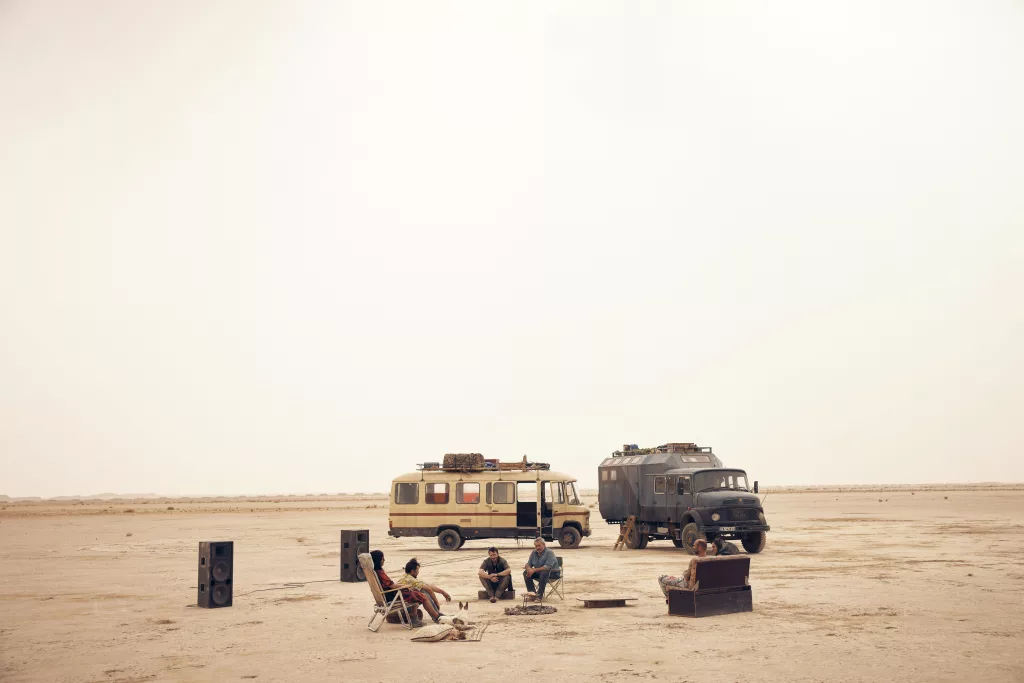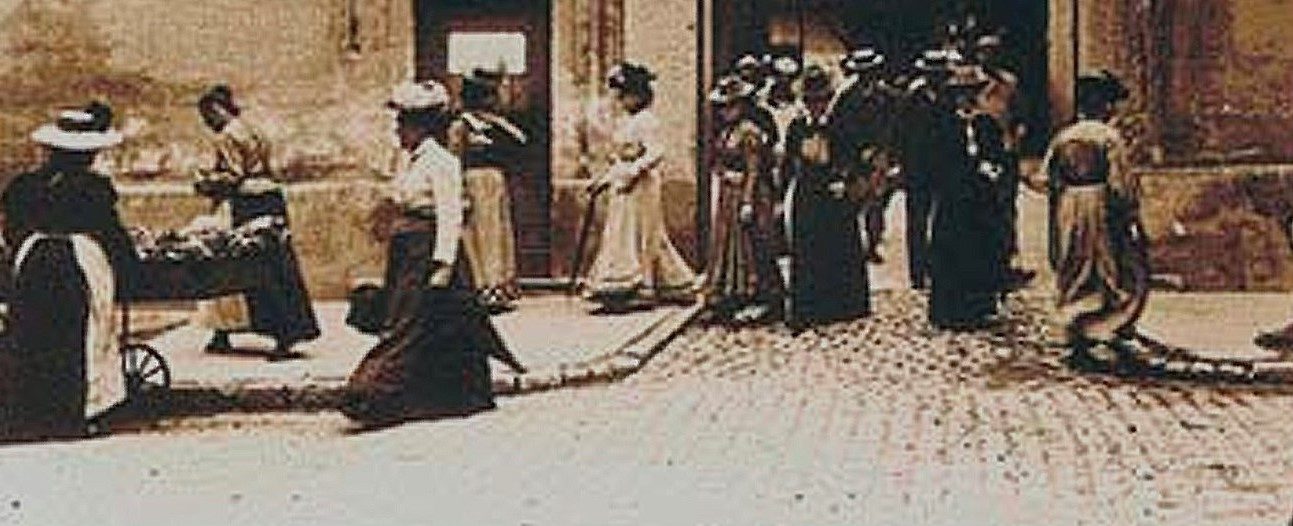France, Spain, 2025
Directed by Oliver Laxe
With Sergi López (Luis), Bruno Núñez (Estéban), Stefania Gadda (Stef), Richard Bellamy (Bigui), Joshua Liam Henderson (Josh), Jade Oukid (Jade), Tonin Janvier (Tonin)

Men, disheveled, tattooed, and bejeweled, sweating under Morocco’s scorching sun moving, piling, and carefully arraying heavy big speakers, like children handling their Lego bricks in their playroom: shot up close this is the opening scene of director Oliver Laxe’s fourth feature. The outcome of the exhausting effort is impressive and a feat of perfect symmetry and high-tech sleekness – and no toy. It is a wall of sound, a carefully assembled pack of speakers standing like an odd construction in the desert, a stunning modern architecture against the awesome reddish massive rocks of the distant foreboding mountains, and ready to broadcast the biggest and wildest sounds of music.
The beats come fast, wrapping the wild and the attending crowd, spurring the folks into trance-like dancing. Their rhythm and ambient and electronic quality cannot be mistaken: this is pure rave music and anyway the images speak as much as the notes as the camera delves into the mass of colorful ravers.
It is easy to get as mesmerized and to feel as free and high as those on the screen: the attraction is real, raw, unavoidable. Yet a portly, middle-aged man with a long-haired boy way too young to attend a rave party and looking after a lovely young pet, stand quickly apart in this sun-scorched, dusty world redefined by partying and pulsing music, seemingly unmoved and even unconcerned. Luis has not come to this gigantic rave party to dance and to stand with the community: a lone wolf, he is looking for his missing daughter. Luis has not been in touch with her for five months and, accompanied and assisted by his other child, Estéban, goes from one rave party to another hoping, if not to find his child, at least to have clues about her whereabouts.
When a small group of ravers tells him that another rave party is planned in Mauritania and that perhaps it could be the one where his daughter could be he decides to follow the caravan of ravers. When the ravers are stopped in their tracks by an operation of the Moroccan military, the small group Luis talked to dares to drive away on a dangerous path, choosing illegality and adventure to go to the next rave party in defiance of the local authorities. Prodded by his son Luis follows the two retrofitted oversized campers, one carrying one-armed Bigui, skinny Liam, and seasoned Stef, the other the couple made up of restive Jade and one-legged Tonin – never mind Luis’ urban minivan and limited cargo of food and drinks are no match for the long bumpy and dicey road travel ahead.
The narrative arc holds little surprises for a long time. It is the old tale of two completely different groups of people learning to get along, the ravers reluctantly accepting an unexpected company they think cannot make it and anyway have no place among the community of ravers, while the stubborn aggrieved father is a cumbersome and unstoppable force refusing to give up and thus forced to ask more and more for help and to accept a fringe group and a fringe culture increasingly fascinating Estéban. It is not yield, however, more information on the characters’ respective backgrounds and insights on their personalities remain limited.
The tough trails, paths, roads the group goes through deliver all the thrills of an adventure film. Twists and turns bring to mind easily the 1953 masterwork of Henri-Georges Clouzot “Le salaire de la peur” – actually, they look like a vague but personal imitation. The ravers’ singular look – makeups, clothes, prostheses, tattoos, and these raucous attitudes – and even more their astonishing bulky vehicles lend a “Mad Max” (1979) quality to “Sirat”, a long way from the working class edge of the 1953 film.
A harrowing tragedy alters profoundly the characters. The spectacular, and stupid, death of Estéban leaves Luis numbed and petrified into a devastating grief he would struggle to come to terms while jolting the ravers out of their relatively carefree expectations and enjoyment, shaped by years spent only chasing rave parties and dancing ragingly and exhilaratingly through life. Arguably, the hurdles met and the uncertainties about where the next party is taking place precisely and where others ravers could be have dampened the initial joie de vivre, and they were still aware, through the radio programs they listen to from time to time, that things are getting pretty ugly in the rest of the world, seemingly faced with a huge geopolitical crisis, but now death has shaken them to the core.
Worst is actually to come, especially when they decide to stop in a vast stretch of sand, not dissimilar to the one when Luis managed at long last to cry and to get a hold on himself earlier. The place highlights how lost the group is really is, stranded in a nearly uninhabited land war does not seem to spare and partying seems impossible. The six travelers decide to make a pause and to shake out of their gloom by improvising their own party. Landmines would actually pitch them to another course.
The long last sequence is even more nail-biting and horrifying than what has been showed until then. It is as powerfully gripping and emotionally overwhelming as it is outrageously shocking and wantonly teasing. But the very reality of surviving or not, while tweaking though that sequence’s surreal and brutal conception the narrative of adventure, is not just a wild outburst of violence decided by fate or a baffling contemplation on the absurdity of human life, with a nothingness feeding helplessness as an ultimate horizon. The strange skyline drawn by the sophisticated heap of speakers against a reddish rocky horizon at the film’s beginning may have been a symbol of a deeper meaning coming in full circle in that unexpected and unsettling final sequence: a radical confrontation between the inventive and cherished melodic sounds of the humans, the technology as well as the ardor they put into creating and enjoying and the harsh reality of an unforgiving world they do little to keep at peace, of the ever-longer litany of dangers, suffering, disasters around them and nearly impossible to escape. Music, whose beats and intensity are brilliantly recorded and used in the editing, does not sound a winner and instead of shrouding the world in its beats end up swallowed in the black hole the sun-burnt sand and glaring sun are and its intensity ends up drown in the flash of death.
This points to deep and unnerving questioning about the meaning of life and death each of us is ready to give and about what survival does mean – the physical and spiritual act as well as the conclusions drawn afterwards deep in the conscience of the survivors. It is unclear both how the survivors in this case managed the feat and as they stare at the horizon on a packed train speeding along even more desert their thoughts are kept opaque. The traumatic experience is a point of no return, the momentum the characters get from music and life has been broken forever by explosions of dust and horror.
The title was a clear indication of what is really at stake in the film, using an Arabic word that refers in the Muslim eschatology to the bridge which spans the chasm of hell and connects this world with paradise and over which according to traditional exegesis only the righteous can cross while the unrighteous fall to a flaming punishment. This religious concept can be complex but in a more grammatical sense; sirat can just mean a path. It is not only a nod to the place where the story unfolds: the filmmaker who made in 2019 “O que arde – Fire Will Come” is himself a believer. His faith is a clear inspiration but so is his love of music and dance, including what rave parties feature. His films have hinted at a strong taste for delving into wild spaces and embracing adventure.
In other words, “Sirat” was to be expected from Laxe. With the assistance of music producer and composer Kangding Ray and long-time collaborators the director of delivers an arguably striking film, boldly injecting an eschatological dimension into reliable narratives, disconcerting the audience and running the risk of getting slammed for playing God arbitrarily (even though it is hard to find any moralistic angle in his portrayal of the characters). Yet the film is adroitly and vibrantly woven into sonic and visual textures that are definitely spellbinding and overwhelming, drawing the audience into a complex, filled with tensions and clashes, nexus of emotions, between the impulse of life, embodied by the rave party, and of freedom, embodied by the characters, and the inescapable but defining reality of death and destruction, and between the paradise we hope and the hell we walk trough. This is not an easy film, easily relatable and understandable, but it is an adventure on its own terms, shot in an electric 16 mm.

